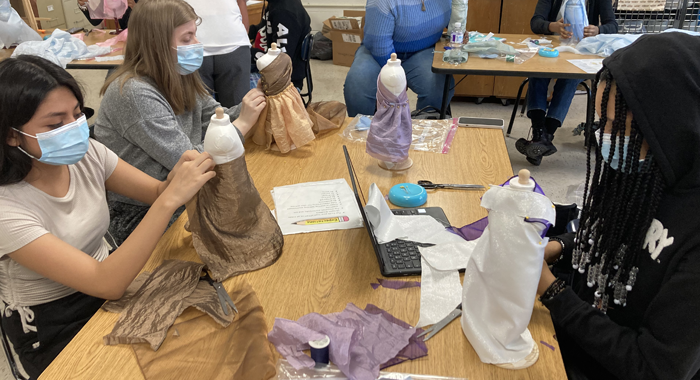Sewing is back in style, with a computerized twist
If you combine art class with entrepreneurship and a healthy layering of social-emotional benefits, you have the vibe found in the Fashion/Construction class at Washington High School. Joan Stekl, family and consumer sciences teacher, leads a group of students in the trifecta of fashion design, photography, and writing, along with creating a marketing poster.
“We’re always looking for electives where students can learn new skills,” said Stekl. “We decided we needed to get this sewing thing back, and we quickly found it was a great way to support kids’ creativity.”
When we visited the classroom, the students were exploring the “draping assignment” where they played the role of fashion designer by creating a draped design on their doll structure. Next steps involved photographing the creation and then writing a dynamic description to accompany the logo and poster design development.
The class falls within the career and technical education program, with an emphasis on learning skills to be used after graduation. “I like the class experience because it’s very hands-on, especially the hand sewing needed for this project,” said Emma, an 11th grader at Washington. “It’s a skill that you might not be able to work on too much at home, so it’s interesting to work on something in a way that you haven’t before.”
The class relies on the 12 sewing machines acquired from a grant that Tara Troester, career and technical education content lead, obtained to set the sewing creativity in motion. It’s noted that the sewing machines “are like computers” with push features to create button holes, zipper work and different stitch patterns. A “beautiful” embroidery machine is the next enhancement coming to the classroom.
When you enter the classroom, the first thing you notice is the quiet, relaxing environment. The students are focused on the task and happy with the notion that their hands are being used to create and not for cell phone scrolling.
While the zen feeling permeates the classroom, the students are also eager to learn from Stekl’s instruction. “We enjoy the mix of gender and ethnicity within the classroom,” said Stekl. “And I worked with my colleague, Jolene Bucheit, engagement specialist, to establish gender-neutral terminology and communication that is inclusive and inviting.”
Sustainability is also taught and emphasized, as students learn to reuse materials. Students use donated items from second-hand stores. Stekl calls this “upcycling skills” and notes that donations of fabric, zippers, buttons, yarn and thread also help the process. She says that students do not have to pay for any materials.
“I’m so impressed with their projects – they’re just amazing,” said Stekl.
Explore more images from the class by clicking the picture below.

